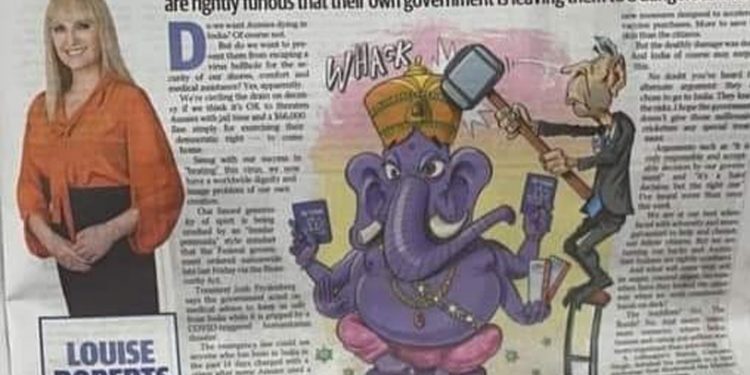Several members of the Australian-Indian community have found a cartoon published by the Daily Telegraph insensitive.
NRI Affairs News Desk
Several members of the Australian-Indian community have found a cartoon, published by the Daily Telegraph, insensitive.
The Daily Telegraph published a cartoon with columnist Louise Roberts’ piece on page 13. The article is about Australians stranded in India due to the COVID-19 pandemic.
The cartoon depicts an Indian, a purple-coloured lord Ganesha, being whacked by a hammer on the head.
Many members of the Australian-Indian community have found the representation in poor taste.
Punya Upadhyaya of Hindus for Human Rights says, “We think this type of unskillful art and editing is a critique of the structural racism and ignorance in some aspects of Australian media. We look forward to a more thoughtful and fact based discussion, one with greater self awareness by media houses. This is a serious crisis with life and death implications- such juvenile distractions detract from the reflective decisions we would like – eg letting all citizens come home as a fundamental right.”
Sydney-based filmmaker and poet Taufeeq Ahmed Sheikh says this is an insensitive caricature despite the headline speaking up for the Indian-Australians stuck in India.
Academic, filmmaker and author Dr Vikrant Kishore find this representation insensitive.
“Well, I think this is insensitive representation. Ganesha is the most well-known Hindu god among the westerners; thus, they need to be sensitive when it comes to just picking this imagery unless they just meant to use an elephant to represent India, but I don’t think they have done their homework! The problem of the West and its ridiculous use of many Indian/Asian symbols and motifs, I guess,” says Dr Kishore, Director for the Bachelor of Film, Television and Animation course at the Deakin University.
Sydney-based former public servant Jai Goyal however says the cartoon should be seen in context.
“What is the purpose of the cartoon? Should we give a knee jerk reaction? I think that will serve their purpose. Should we shoot the messenger? Should we do a tit for tat? I know they have made worse cartoons on their own religion. So if the content of the article is in sync with the cartoon, I will not be angry,” said Mr Goyal.
In 2017, a Meat & Livestock Australia advertisement, featuring various religious figures, including Ganesha, had upset many Australian-Indians who considered Ganesha vegetarian.
MLA had later pulled the advertisement.
Gaṇesha, also known as Ganapati and Vinayaka, is one of the best-known and most worshipped deities in Hinduism.
According to a spiritual Indian organisation, The Art of Living, “Ganesha is the formless Divinity – encapsulated in a magnificent form, for the benefit of the devotee. As per Hindu mythology, he is the son of Lord Shiva and Goddess Parvati.”
‘This clearly is a lazy attempt by the cartoonist at creating imagery that would come across as representative of all Indians. But not all Indians are Hindu. Not all Hindus worship this particular god either I’m guessing. Australian media needs to understand the cultural nuances of South Asian culture better,” says Mudit Vyas, an International student in Melbourne.
A petition demanding an apology has also been launched on change.org.
“Australia is a multi-cultural society, and no one has the right to disrespect any faith or religion. The Daily Telegraph have insulted Hindu Diety (Ganesha) which is utterly disrespectful to the faith of Hindus living in Australia and abroad. There are many ways to depict something but why insult someone’s faith,” reads the petition.
NRI Affairs have approached The Daily Telegraph for a comment, and the response is awaited.











